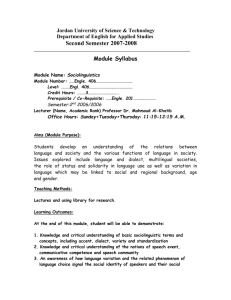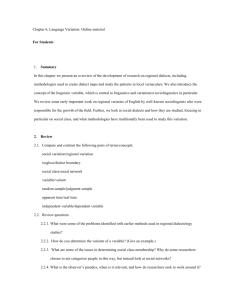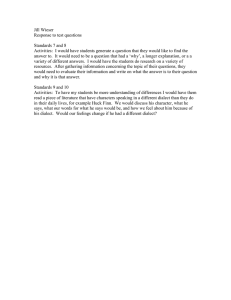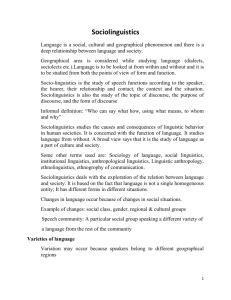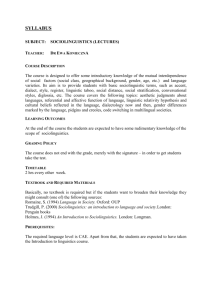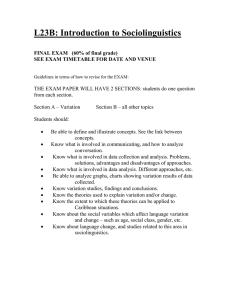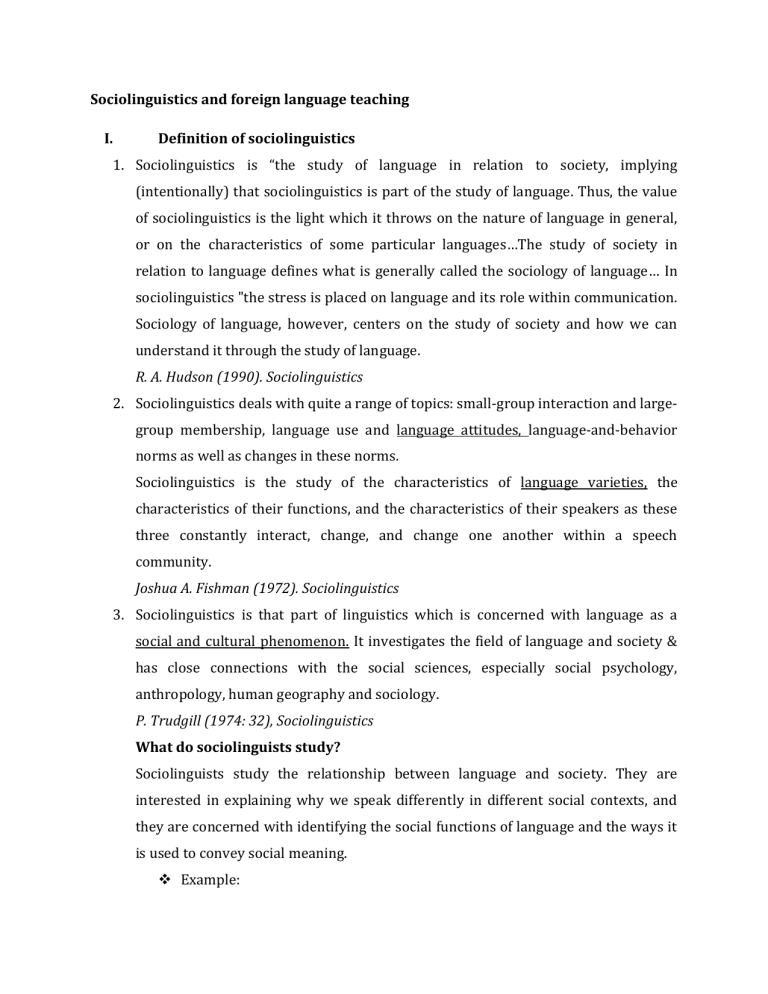
Sociolinguistics and foreign language teaching I. Definition of sociolinguistics 1. Sociolinguistics is “the study of language in relation to society, implying (intentionally) that sociolinguistics is part of the study of language. Thus, the value of sociolinguistics is the light which it throws on the nature of language in general, or on the characteristics of some particular languages…The study of society in relation to language defines what is generally called the sociology of language… In sociolinguistics "the stress is placed on language and its role within communication. Sociology of language, however, centers on the study of society and how we can understand it through the study of language. R. A. Hudson (1990). Sociolinguistics 2. Sociolinguistics deals with quite a range of topics: small-group interaction and largegroup membership, language use and language attitudes, language-and-behavior norms as well as changes in these norms. Sociolinguistics is the study of the characteristics of language varieties, the characteristics of their functions, and the characteristics of their speakers as these three constantly interact, change, and change one another within a speech community. Joshua A. Fishman (1972). Sociolinguistics 3. Sociolinguistics is that part of linguistics which is concerned with language as a social and cultural phenomenon. It investigates the field of language and society & has close connections with the social sciences, especially social psychology, anthropology, human geography and sociology. P. Trudgill (1974: 32), Sociolinguistics What do sociolinguists study? Sociolinguists study the relationship between language and society. They are interested in explaining why we speak differently in different social contexts, and they are concerned with identifying the social functions of language and the ways it is used to convey social meaning. Example: Ray: Hi mum Mum: Hi. You’re late Ray: Yeah, that bastard Sootbucket kept us in again Mum: Nana’s here Ray: Oh sorry. Where is she? Ray: Good afternoon, sir Principal: What are you doing here at this time? Ray: Mr Sutton kept us in, sir II. Key concepts of sociolinguistics 1. Language vs. languages [Video] Language (uncountable) refers to people’s ability to speak to and understand each other using their mouths, ears and brains. When they are using that general ability called language, they're also using a specific language. If one says "I like doing research into language" it would mean they want to learn about a) how language came about b) the history of language c) different types of language i.e. verbal and non-verbal, d) the impact that language has had and continues to have... In other words how/why/how long we have been communicating with each other using verbal cues. If anyone says "I like doing research into languages" I would assume they meant a)how different communities express themselves b)how different languages affect national cultures and vice-versa c) why one 'root' language develops into different separate languages and how it does so. If the person says "I like doing research into the English (or Spanish, or Malaysian etc.) language" I would assume they know that language but wanted to learn more about its vocabulary, grammar, etymology and history. 2. Lect and types of lects Lect refers to the different ways people speak. In sociolinguistics, language variety—also called lect—is a general term for any distinctive form of a language or linguistic expression. Linguists commonly use language variety (or simply variety) as a cover term for any of the overlapping subcategories of a language, including dialect, register, jargon, idiolect, etc. a. Dialect The word dialect—which contains "lect" within the term—derives from the Greek words dia- meaning "across, between" and legein "speak." A dialect is a regional or social variety of a language distinguished by pronunciation, grammar, and/or vocabulary. The term dialect is often used to characterize a way of speaking that differs from the standard variety of the language. Dialect, a variety of a language that signals where a person comes from. The notion is usually interpreted geographically (regional dialect), but it also has some application in relation to a person’s social background (class dialect) or occupation (occupational dialect). The word dialect comes from the Ancient Greek dialektos “discourse, language, dialect,” which is derived from dialegesthai “to discourse, talk.” A dialect is chiefly distinguished from other dialects of the same language by features of linguistic structure—i.e., grammar (specifically morphology and syntax) and vocabulary. In morphology (word formation), various dialects in the Atlantic states have clim, clum, clome, or cloome instead of climbed, and, in syntax (sentence structure), there are “sick to his stomach,” “sick at his stomach,” “sick in,” “sick on,” and “sick with.” On the level of vocabulary, examples of dialectal differences include American English subway, contrasting with British English underground; and corn, which mean “maize” in the United States, Canada, and Australia, “wheat” in England, and “oats” in Scotland. Nevertheless, while dialects of the same language differ, they still possess a common core of features. Varieties Of Dialects Geographic dialects The most widespread type of dialectal differentiation is regional, or geographic. As a rule, the speech of one locality differs at least slightly from that of any other place. Differences between neighboring local dialects are usually small, but, in traveling farther in the same direction, differences accumulate. Geographic dialects include local ones (e.g., the Yankee English of Cape Cod or of Boston, the Russian of Moscow or of Smolensk) or broader regional ones, such as Delaware Valley English, Australian English, or Tuscan Italian. Such entities are of unequal rank; South Carolina English, for instance, is included in Southern American English Social dialects Another important axis of differentiation is that of social strata. In many localities, dialectal differences are connected with social classes, educational levels, or both. More-highly educated speakers and, often, those belonging to a higher social class tend to use more features belonging to the standard language, whereas the original dialect of the region is better preserved in the speech of the lower and less-educated classes. For Fishman (1979), in common usage, a dialect is usually a regional subunit with respect to the language in question, particularly in its idiomatic or spoken forms of expression. ‘Language’ is a superordinate designation whilst ‘dialect’ is the subordinate term. In the popular definition offered by Fishman (op. cit.), for example, ‘dialect’ is associated with territoriality, being coined according to linguistic geography. According to this view, the description of the forms of the regional varieties of a language geographically would be down to dialectology, and language varieties that basically represent diverse geographical origins would be referred to as ‘dialects’. b. Jargon Jargon refers to the specialized language of a professional or occupational group. Such language is often meaningless to outsiders. American poet David Lehman has described jargon as "the verbal sleight of hand that makes the old hat seem newly fashionable; it gives an air of novelty and specious profundity to ideas that, if stated directly, would seem superficial, stale, frivolous, or false." In other words, jargon is a faux method of creating a sort of dialect that only those on this inside group can understand. Jargon has social implications similar to dialect prejudice but in reverse: It is a way of making those who understand this particular variety of language more erudite and learned; those who are members of the group that understands the particular jargon are considered smart, while those on the outside are simply not bright enough to comprehend this kind of language. c. Ethnolect A lect spoken by a specific ethnic group. For example, Ebonics, the vernacular spoken by some African-Americans, is a type of ethnolect, notes e2f, a languagetranslation firm. d. Idiolect According to e2f, the language or languages spoken by each individual. For example, if you are multilingual and can speak in different registers and styles, your idiolect comprises several languages, each with multiple registers and styles. An idiolect is the dialect of an individual person at one time. This term implies an awareness that no two persons speak in exactly the same way and that each person’s dialect is constantly undergoing change—e.g., by the introduction of newly acquired words. Most recent investigations emphasize the versatility of each person’s speech habits according to levels or styles of language usage. 3. Lingua franca Etymology From the Italian, "language" + "Frankish" A lingua franca is a language used for communication between people whose first language differ Janet Homes (2001:78). An introduction to Sociolinguistics. A lingua franca is a language or mixture of languages used as a medium of communication by people whose native languages are different. Also known as a trade language, contact language, international language, and global language. Example (78) 4. Pidgin A pidgin is a language which has no native speakers. Pidgins develop as a means of communication between people who do not have a common language. So a pidgin is no one’s native language. Pidgins seem particularly likely to arise when two groups with different languages are communicating in a situation where there is also a third dominant language. Janet Homes (2001:81). An introduction to Sociolinguistics. Functions: a narrow range of functions, an addition to their linguistic repertoire used for a specific purpose, such as trade and administration Example Linguistic structure of pidgin: Because pidgins develop to serve a very narrow range of functions in a very restricted set of domains, they tend to have a simplified structure and a small vocabulary compared with fully developed languages. Example >> Pidgin languages signal only a minimum of grammatical information Identifying characteristics: + It is used in restricted domains and functions + It has a simplified structure compared to the source language + It generally has low prestige and attracts negative attitudes – especially from outsiders. Video: Pidgin vs. Creoles 5. Register 6. Register is defined as the way a speaker uses language differently in different circumstances. Think about the words you choose, your tone of voice, even your body language. You probably behave very differently chatting with a friend than you would at a formal dinner party or during a job interview. These variations in formality, also called stylistic variation, are known as registers in linguistics. 7. They are determined by such factors as social occasion, context, purpose, and audience. Registers are marked by a variety of specialized vocabulary and turns of phrases, colloquialisms, the use of jargon, and a difference in intonation and pace. 8. Registers are used in all forms of communication, including written, spoken, and signed. Depending on grammar, syntax, and tone, the register may be extremely rigid or very intimate. You don't even need to use an actual word to communicate effectively. A huff of exasperation during a debate or a grin while signing "hello" speaks volumes. Definitions “Styles are often analyzed along a scale of formality… Register, on the other hand, when they are distinguished from styles, tend to be associated with particular groups of people or sometimes specific situations of use. The term register here describes the language of groups of people with common interests, or jobs, or language used in situations associated with such groups.” Holmes, J. (2001: 246). An Introduction to Sociolinguistics. Examples: journalese, baby-talk, legalese, the language of auctioneers, race-callers, and sports commentators, the language of airline pilots, criminals, financiers, politicians, the language of the courtroom and the classroom,etc. In sociolinguistics, the term register refers to specific lexical and grammatical choices as made by speakers depending on the situational context, the participants of a conversation and the function of the language in the discourse (cf. Halliday 1989, 44). According to M.A.K. Halliday, there are two main types of variation in language, social and functional. Dialects are characterized by social or regional variation, whereas register concerns functional variation. However, these two notions are not entirely independent of each other. Hudson (1993, 51) states that “one man’s dialect is another man’s register.”, i.e. linguistic features which are part of one speaker’s dialect might belong to a specific register for another speaker. Nevertheless, many linguists hold the view that speakers often only control one or two social varieties of language (standard and dialect), while they use a “wide range of registers” (Barnickel 1982, 13; Biber 2000, 135; Halliday 1990, 43; Trudgill 1983). In contrast to dialect, which Halliday (1990, 41) defines as a “variety of language according to the user”, register focuses on the “variety according to use.” Thus, register is characterized by “differences in the type of language selected as appropriate to different types of situation” (Halliday et. al. 1964, 87), which means that there is a close relationship between language and context of situation. In linguistics, the register is defined as the way a speaker uses language differently in different circumstances. Think about the words you choose, your tone of voice, even your body language. You probably behave very differently chatting with a friend than you would at a formal dinner party or during a job interview. These variations in formality, also called stylistic variation, are known as registers in linguistics. They are determined by such factors as social occasion, context, purpose, and audience. Registers are marked by a variety of specialized vocabulary and turns of phrases, colloquialisms and the use of jargon, and a difference in intonation and pace; in "The Study of Language," linguist George Yule describes the function of jargon as helping " to create and maintain connections among those who see themselves as 'insiders' in some way and to exclude 'outsiders'." Registers are used in all forms of communication, including written, spoken, and signed. Depending on grammar, syntax, and tone, the register may be extremely rigid or very intimate. You don't even need to use an actual word to communicate effectively. A huff of exasperation during a debate or a grin while signing "hello" speaks volumes. Linguistic features of registers from a sports announcer talk Syntactic reduction Example from baseball or cricket commentaries (a) [It] bounced to second base (b) [It’s] a breaking ball base (c) [He’s a] guy who’s a pressure player (d) McCatty [is] in difficulty (e) Tucker [is] taking a few ah stuttering steps down the wicket from the bowler’s end but Waugh [is] sending him back Syntactic inversion Example from baseball or cricket commentaries (a) In comes Ghouri (b) And all set again is Pat Haden (c) On deck is big Dave Winfield (d) Pete goes to right field and back for it goes Jackson Heavy noun modification Example from baseball or cricket commentaries (a) David Winfield, the 25-million-dollar man, who is hitting zero, five, six in this World series… (b) First-base umpire Larry Barnett… (c) This much sought-after and very expensive fast bowler Types of Linguistic Register Some linguists say there are just two types of register: formal and informal. This isn't incorrect, but it is an oversimplification. Instead, most who study language say there are five distinct registers. Frozen: This form is sometimes called the static register because it refers to historic language or communication that is intended to remain unchanged, like a constitution or prayer. Examples: The Bible, the United States Constitution, the Bhagavad Gita, "Romeo and Juliet" Formal: Less rigid but still constrained, the formal register is used in professional, academic, or legal settings where communication is expected to be respectful, uninterrupted, and restrained. Slang is never used, and contractions are rare. Examples: a TED talk, a business presentation, the Encyclopedia Brittanica, "Gray's Anatomy," by Henry Gray. Consultative: People use this register often in conversation when they're speaking with someone who has specialized knowledge or who is offering advice. Tone is often respectful (use of courtesy titles) but may be more casual if the relationship is longstanding or friendly (a family doctor). Slang is sometimes used, people may pause or interrupt one another. Examples: the local TV news broadcast, an annual physical, a service provider like a plumber. Casual: This is the register people use when they're with friends, close acquaintances and coworkers, and family. It's probably the one you think of when you consider how you talk with other people, often in a group setting. Use of slang, contractions, and vernacular grammar is all common, and people may also use expletives or off-color language in some settings. Examples: a birthday party, a backyard BBQ. Intimate: Linguists say this register is reserved for special occasions, usually between only two people and often in private. Intimate language may be something as simple as an inside joke between two college friends or a word whispered in a lover's ear. III. Bilingualism, Biculturalism, Intercultural/ Cross-cultural communication, language and power, language and gender 1. Bilingualism vs. Biculturalism When you research the internet for information about bilingualism, a word that often pops up is biculturalism. A lot of people would assume that it is the same thing, but this is not the case. Some people assume that if you raise a child to be bilingual, that child will automatically have access to another culture. While it helps, it’s not quite that easy — bilingualism is more of a door into biculturalism. Definitions Bilingualism is the ability to communicate in two languages. It generally implies writing, reading, and speaking fluently, although the term is also sometimes applied to individuals who are only bilingual speakers, and not literate in a second language. Biculturalism is an immersion in two distinct cultures, implying participation in traditional heritage practices like food, dress, family traditions, folklore and folk art, etc. Speaking a heritage language is often an important part of biculturalism. However, the immersion goes beyond that. Biculturalism is often, but not always, the product of a bicultural family, usually one made from a cross-cultural marriage. It is important to point out in relation to bilingualism, the two are related, but are not the same. You could say bilingualism is a door into biculturalism. 2. Multiculturalism, Interculturalism vs. Cross-culturalism communication What is the difference between multicultural, cross-cultural, and intercultural? While they all might be under the same roof, they describe entirely different rooms. Multicultural refers to a society that contains several cultural or ethnic groups. People live alongside one another, but each cultural group does not necessarily have engaging interactions with each other. For example, in a multicultural neighborhood people may frequent ethnic grocery stores and restaurants without really interacting with their neighbors from other countries. Cross-cultural deals with the comparison of different cultures. In cross-cultural communication, differences are understood and acknowledged, and can bring about individual change, but not collective transformations. In cross-cultural societies, one culture is often considered “the norm” and all other cultures are compared or contrasted to the dominant culture. Intercultural describes communities in which there is a deep understanding and respect for all cultures. Intercultural communication focuses on the mutual exchange of ideas and cultural norms and the development of deep relationships. In an intercultural society, no one is left unchanged because everyone learns from one another and grows together. 3. Language and power ‘Power’ refers to the ability of an entity (e.g., company, individual, social group, etc.) to make change, or conversely, to maintain things as they are. In discussing the power of language, we need to consider two distinct uses of language: • Language as public discourse: the language used in the public print media, television and radio, and now, on the Web. • Language as interpersonal communication: the language used when we as individuals interact with other individuals, e.g., friends talking, doctor and patient, teacher and students. Power in Public Discourse In one sense, the word ‘power’ refers to the power of dominant institutions within our society, and how these institutions maintain their dominance through the use of language: media (newspapers, television), advertising, etc. The power of language in public discourse refers to the ability to control the flow of information: what gets into the press, and how it is presented. The public media is the primary means of shaping public opinion. So, the news we read or hear is shaped by a complex interaction of ideologies, a fight between those of the owners, the advertisers, the news staff, and the viewing public. Power in Interpersonal Communication A second sense of ‘power’ is more personal, referring to the power of individuals to influence interactions with others: allowing individuals to be more ‘powerful’ in the sense of being able to achieve their personal goals. Part of the power of an individual is personal, stemming from their mastery of linguistic skills: knowing when to speak (and when not to speak), and how to speak. Most of us know the situation of wanting to have our say, but not being sure when to appropriately interrupt, and thus staying silent and feeling powerless. And we have seen those who are always listened to, and believed, even if someone else said the same thing five minutes before, with less belief. Another part of power stems from the social roles that the individual fills. A doctor talking to a patient inherits the power of his role from the institutional practices we are socialised into: we are trained from a young age into showing respect for our doctor, letting them control the interaction, and answering their questions as well as we can. If we meet our doctor in a different setting (e.g., at a social gathering), then we might interact with them not as a doctor-patient, but more as equals. Power also stems from the social relationships we have formed with those with whom we talk. Do they trust us or not? (credibility), do they like us? do they respect us? The amount they listen to us and allow us to influence them depends on these factors. If what one says is always worth listening to, then whenever one speaks, those that know you will listen. Summary • When considering ‘language & power’ one needs to distinguish public power vs. personal power • Public power is the ability to shape public opinion, and thus to change or maintain the social reality. • Public power is controlled by institutions, but also by more vaguely defined ideological collectives. • Personal power is the ability to change or maintain one’s local social reality. • Personal power stems from social roles, social relationships, and personal language competence. Example: Barack Obama 4. Language and gender "Across all social groups in Western societies, women generally use more standard grammatical forms than men and so, correspondingly, men use more vernacular forms than women... "[I]t is worth noting that although gender generally interacts with other social factors, such as status, class, the role of the speaker in an interaction, and the (in)formality of the context, there are cases where the gender of the speaker seems to be the most influential factor accounting for speech patterns. In some communities, a woman's social status and her gender interact to reinforce differential speech patterns between women and men. In others, different factors modify one another to produce more complex patterns. But in a number of communities, for some linguistic forms, gender identity seems to be a primary factor accounting for speech variation. The gender of the speaker can override social class differences, for instance, in accounting for speech patterns. In these communities, expressing masculine or feminine identity seems to be very important." (Janet Holmes, An Introduction to Sociolinguistics, 4th ed. Routledge, 2013) “Our use of language embodies attitudes as well as referential meantings. Woman’s language has its foundation the attitude that women are marginal to the serious concerns of life, which are preempted by men.” (Robin Lakoff: Language and the Woman’s Place, 1975) According to Lakoff, women’s talk has the following properties: 1) A large set of words specific to their interests: e.g. color words like magenta, shirr, dart (in sewing), etc. 2) “Empty” adjectives such as divine, precious, lovely, cute, etc. 3) Tag questions and rising intonation in statement contexts: What’s your name dear? Mary Smith? 4) Use of hedges 5) Use of intensive “so” 6) Hypercorrect grammar: women are not supposed to talk rough 7) Super-politeness 8) Ask more questions Deborah Tannen, 1990. You Just Don’t Understand: Women and Men in Conversation Women speak a language of connection and intimacy Men speak a language of status and independence >> Their communication can be like cross-cultural communication. What is Gender-Biased Language? · · If language is gender biased, it favors a certain gender over another. In the case of English, the particular bias is usually the preference of the masculine over the feminine. · At first glance, it would appear that gender bias is built into the English language. Rules of grammar once dictated that we use masculine pronouns (he, his, him, himself) whenever a singular referent is required and we don’t know the gender of the person we’re talking about · Though this practice has been changing there are still some words that we use regularly that include the feminine. Consider the following examples: Workmen’s Compensation, mankind, chairman, man-made.


